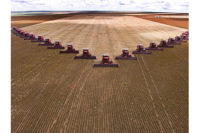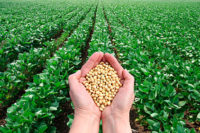We all depend on Mother Nature to determine whether we get our annual bonus or a sad face from our boss. We’re aware that crop pricing is a global issue and no longer just a domestic issue, but this discussion focuses on our domestic situation. Last year at this time we had a lot of corn and soybeans planted in Iowa, South Dakota, Ohio, Indiana, Illinois, Minnesota and Nebraska. Many thought that we would have a near-record crop and inexpensive corn, but the opposite occurred. Who could have imagined that a drought of such proportion would occur in the USA?
Folks in Nebraska suffered diminished yield due to the drought. However, because the majority of the state is irrigated, many Nebraskan farmers still made a very handy profit.
On the other hand, Iowa, Ohio, Illinois, Indiana, South Dakota and Missouri suffered mightily. Typically in parts of Iowa, anyone can grow corn, so why invest in irrigation or liquid fertilizer? Portions of the state were lucky enough to get enough rain to squeeze out a crop, but vast portions had nothing but dead vegetation.
This year the planters are out in full force, though we are late planting compared to last year. The crops will be in the ground soon. According to the USDA report, farmers will plant approximately 97.3 million acres of corn — the most corn planted in more than 75 years. We will also plant close to a record acreage of soybeans. Logic would tell us that this should result in a record crop … that is, if we don’t have another drought.
How often does history repeat itself with back-to-back drought years? The National Weather Service drought forecast map (see Figure 1) is bleak from northwest Iowa westward through California, with pockets of improvement from last year along the very eastern line of the drought.
The states of Ohio, Indiana, Missouri, eastern to central Iowa and Illinois all look great, but as we all know, never trust the weatherman or the forecasters. Federal researchers say there is less than a 20% chance the drought will end by October. Predictions are for another very dry summer for all parts of the U.S. west of Omaha and Kansas City.
Regardless, we know the corn and soybean supplies will be very tight until we harvest in late September or October, as the crop will be 15 to 30 days late versus last year. Those of you close to the coast who bought corn and soybeans from other areas around the globe, i.e. Brazil and Argentina, get a gold star for creativity. U.S. soybean imports were up 100,000,000 bushels.
I see a few cows returning to the feedlot, but it still looks pretty sparse compared to last year. Poultry appears to be stealing market share away from beef again because of the tight supply. By the time this is published, we could have a farm bill.
Currently, the House and the Senate are miles apart on the level of spending to be cut from Supplemental Nutrition Assistance Programs (SNAP). The current House bill reduces CRP maximums from the current 32,000,000 acres to 27,000,000 acres. There are no livestock titles in either House or Senate bill, and neither includes the HSUS/United Egg Producers’ agreement on cage sizes for laying hens. If we could just get the government to pay us not to grow livestock, that would solve everybody’s problems.
We will all cross our fingers and hope for rain. If the rain comes early and at a critical time, domestic feed ingredients will be much more affordable this year.
Time will tell.
Dan Emery has 25 years experience in the food industry, including 15 as vice president of marketing at Pilgrim’s Pride. He is directing Meaningful Solutions, a company founded to assist clients in solving problems.








